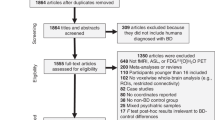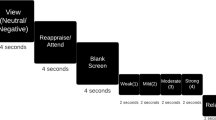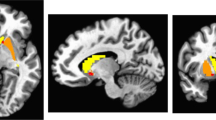Abstract
Recent neuropsychological studies in healthy volunteers suggest that antidepressants enhance the processing of positive emotional information. However, the neural substrates underpinning these changes have not been fully elucidated. The current study, therefore, used functional magnetic resonance imaging (fMRI) to map brain systems activated during successful categorization and subsequent recognition of self-referent positive and negative personality characteristics in healthy volunteers following short-term (7 days) repeated administration of the selective noradrenergic reuptake inhibitor reboxetine. Twenty-four healthy volunteers were randomly assigned to 7-day double-blind intervention with reboxetine or placebo. On day 7, neural responses during the categorization and subsequent recognition of positive and negative characteristics were assessed using fMRI. Questionnaires monitoring mood, hostility and anxiety were given before and during this intervention. During categorization, reboxetine was associated with greater activation to positive words, relative to negative words, in left precuneus and right inferior frontal gyrus. By contrast, at subsequent recognition reboxetine was associated with reduced response to positive words, relative to negative words, in left precuneus, anterior cingulate and medial frontal gyrus. These changes in the neural processing of positive and negative words occurred in the absence of significant differences in ratings of mood and anxiety. Such adaptations in the neural processing of emotional information support the hypothesis that antidepressants have early effects on emotional processing in a manner which would be expected to reverse negative biases in depression.
This is a preview of subscription content, access via your institution
Access options
Subscribe to this journal
Receive 12 print issues and online access
$259.00 per year
only $21.58 per issue
Buy this article
- Purchase on Springer Link
- Instant access to full article PDF
Prices may be subject to local taxes which are calculated during checkout





Similar content being viewed by others
References
Nitschke JB, Heller W, Etienne MA, Miller GA . Prefrontal cortex activity differentiates processes affecting memory in depression. Biol Psychiatry 2004; 67: 125–143.
Beck AT . Cognitive Theory and the Emotional Disorders. International University Press: New York, 1976.
Mayberg HS, Liotti M, Brannan SK, McGinnis S, Mahurin RK, Jerabek PA et al. Reciprocal limbic-cortical function and negative mood: converging PET findings in depression and normal sadness. Am J Psychiatry 1999; 156: 675–682.
Harmer CJ, Shelley NC, Cowen PJ, Goodwin GM . Increased positive versus negative affective perception and memory in healthy volunteers following selective serotonin and norepinephrine reuptake inhibition. Am J Psychiatry 2004; 161: 1256–1263.
Harmer CJ, Hill SA, Taylor MJ, Cowen PJ, Goodwin GM . Toward a neuropsychological theory of antidepressant drug action: increase in positive emotional bias after potentiation of norepinephrine activity. Am J Psychiatry 2003; 160: 990–992.
Kent JM, Coplan JD, Gorman JM . Clinical utility of the selective serotonin reuptake inhibitors in the spectrum of anxiety. Biol Psychiatry 1998; 44: 812–824.
Fossati P, Hevenor SJ, Graham SJ, Grady C, Keightley ML, Craik F et al. In search of the emotional self: an FMRI study using positive and negative emotional words. Am J Psychiatry 2003; 160: 1938–1945.
Fossati P, Hevenor SJ, Lepage M, Graham SJ, Grady C, Keightley ML et al. Distributed self in episodic memory: neural correlates of successful retrieval of self-encoded positive and negative personality traits. Neuroimage 2004; 22: 1596–1604.
Lane RD, Fink GR, Chau PM, Dolan RJ . Neural activation during selective attention to subjective emotional responses. Neuroreport 1997; 8: 3969–3972.
Moran JM, Macrae CN, Heatherton TF, Wyland CL, Kelley WM . Neuroanatomical evidence for distinct cognitive and affective components of self. J Cogn Neurosci 2006; 19: 1586–1594.
Craik FIM, Moroz TM, Moscovitch M, Stuss DT, Winocur G, Tulving E et al. In search of self: a positron emission tomography study. Psychol Sci 1999; 10: 26–34.
Vuilleumier P . How brains beware: neural mechanisms of emotional attention. Trends Cogn Sci 2005; 9: 585–594.
Johnson SC, Baxter LC, Wilder LS, Pipe JG, Heiserman JE, Prigatano GP . Neural correlates of self-reflection. Brain 2002; 125 (Part 8): 1808–1814.
Phan KL, Wager T, Taylor SF, Liberzon I . Functional neuroanatomy of emotion: a meta-analysis of emotion activation studies in PET and fMRI. Neuroimage 2002; 16: 331–348.
Miskowiak K, Papadatou-Pastou M, Cowen PJ, Goodwin GM, Norbury R, Harmer C . Single dose antidepressant administration modulates the neural processing of self-referent personality trait words. Neuroimage 2007; 37: 904–911.
Taylor MJ, Freemantle N, Geddes JR, Bhagwagar Z . Early onset of selective serotonin reuptake inhibitor antidepressant action: systematic review and meta-analysis. Arch Gen Psychiatry 2006; 63: 1217–1223.
Spitzer RL, Williams JBW, Gibbon M, First MB . Structured Clinical Interview for the DSM-IV (SCID-I/P) Version II. American Psychiatric Press: Washington, DC, 1995.
Nelson HE . National Adult Reading Test 2nd edn. NFER-Nelson: Windsor, UK, 1991.
von Zerrsen D, Strian F, Schwarz D . Evaluation of depressive states, especially in longitudinal studies In: Basel PP (ed) Psychological Measurements in Psychopharmacology. Karger: Switzerland, 1974; 37: 904–911.
Watson D, Clark LE, Tellegen A . Development and validation of brief measures of positive and negative affect: the PANAS. J Pers Soc Psychol 1988; 54: 1063–1070.
Spielberger CD, Gorusch RL, Lushene RD . STAI Manual. Consulting Psychologists Press: Palo Alto, CA, 1970.
Buss AH, Durkee A . An inventory for assessing different kinds of hostility. J Consult Psychol 1957; 21: 343–349.
Beck AT, Ward CH, Mendelson M, Mock J, Erbaugh J . An inventory for measuring depression. Arch Gen Psychiatry 1961; 4: 561–571.
Bos C, Dubini A, Polin V . Development and validation of a social functioning scale: the social adaptation self-evaluation scale. Eur Neuropscyhopharmacol 1997; 7 (Suppl 1): S57–S70.
Anderson NH . Likeableness ratings of 555 personality-trait words. J Pers Soc Psychol 1968; 9: 272–279.
Francis WN, Kucera A . Frequency Analysis of English Usage: Lexicon and Grammar. Houghton Mifflin: Boston, MA, 1982.
Smith SM, Jenkinson M, Woolrich MW, Beckman CF, Behrens TEJ, Johansen-Berg H et al. Advances in functional and structural MR image analysis and implementation as FSL. Neuroimage 2004; 23: S208–S219.
Jenkinson M, Bannister P, Brady M, Smith S . Improved optimization for the robust and accurate linear registration and motion correction of brain images. Neuroimage 2002; 17: 825–841.
Smith S . Fast robust automated brain extraction. Hum Brain Mapp 2002; 17: 143–155.
Jenkinson M, Smith S . A global optimisation method for robust affine registration of brain images. Med Image Anal 2001; 5: 143–156.
Woolrich MW, Ripley BD, Brady M, Smith SM . Temporal autocorrelation in univariate linear modeling of FMRI data. Neuroimage 2001; 14: 1370–1386.
Woolrich MW, Behrens TE, Beckmann CF, Jenkinson M, Smith SM . Multilevel linear modelling for FMRI group analysis using Bayesian inference. Neuroimage 2004; 21: 1732–1747.
Friston KJ, Worsley KJ, Frackowiak RSJ, Mazziotta JC, Evans AC . Assessing the significance of focal activations using their spatial extent. Hum Brain Mapp 1994; 1: 210–220.
Talairach J, Tournoux P . Co-Planar Stereotaxic Atlas of the Human Brain: Three-Dimensional Proportional System. Thieme Medical: New York, 1988.
Pollack I, Norman DA . A nonparametric analysis of recognition experiments. Psychon Sci 1964; 1: 125–126.
Ofek E, Pratt H . Neurophysiological correlates of subjective significance. Clin Neurophysiol 2005; 116: 2354–2362.
Callicott JH, Mattay VS, Verchinski BA, Marenco S, Egan MF, Weinberger DR . Complexity of prefrontal cortical dysfunction in schizophrenia: more than up or down. Am J Psychiatry 2003; 160: 2209–2215.
Rugg MD, Wilding EL . Retrieval processing and episodic memory. Trends Cogn Sci 200; 4: 108–115.
Daselaar SM, Rice HJ, Greenberg DL, Cabeza R, Labar KS, Rubin DC . The spatiotemporal dynamics of autobiographical memory: neural correlates of recall, emotional intensity, and reliving. Cereb Cortex 2007; E-pub ahead of print.
Fleck MS, Daselaar SM, Dobbins IG, Cabeza R . Role of prefrontal and anterior cingulate regions in decision-making processes shared by memory and nonmemory tasks. Cereb Cortex 2006; 16: 1623–1630.
Pardo JV, Pardo PJ, Janer KW, Raichle ME . The anterior cingulate cortex mediates processing selection in the Stroop attentional conflict paradigm. Proc Natl Acad Sci USA 1990; 87: 256–259.
Posner MI, Petersen SE . The attention system of the human brain. Annu Rev Neurosci 1990; 13: 25–42.
Posner MI, Dehaene S . Attentional networks. Trends Neurosci 1994; 17: 75–79.
Cabeza R, Nyberg L . Imaging cognition II: an empirical review of 275 PET and fMRI studies. J Cogn Neurosci 2000; 12: 1–47.
Fletcher PC, Dolan RJ, Frith CD . The functional anatomy of memory. Experientia 1995; 51: 1197–1207.
Bonne O, Krausz Y, Aharon Y, Gelfin Y, Chisin R, Lerer B . Clinical doses of fluoxetine and cerebral blood flow in healthy volunteers. Psychopharmacology (Berl) 1999; 143: 24–28.
Acknowledgements
This study was supported by the Medical Research Council, UK. We thank the staff at OCMR for their help in data acquisition. We are also grateful to all the volunteers who took part in the study.
Author information
Authors and Affiliations
Corresponding author
Additional information
This study was presented in part at the 18th European College of Neuropsychopharmacology Congress, Amsterdam, The Netherlands, 22–26 October, 2005.
Rights and permissions
About this article
Cite this article
Norbury, R., Mackay, C., Cowen, P. et al. The effects of reboxetine on emotional processing in healthy volunteers: an fMRI study. Mol Psychiatry 13, 1011–1020 (2008). https://doi.org/10.1038/sj.mp.4002091
Received:
Revised:
Accepted:
Published:
Issue Date:
DOI: https://doi.org/10.1038/sj.mp.4002091
Keywords
This article is cited by
-
How do Mindfulness-Based Programs Improve Depression Symptoms: Selflessness, Valence, or Valenced Self?
Cognitive Therapy and Research (2022)
-
Healthy individuals treated with clomipramine: an fMRI study of brain activity during autobiographical recall of emotions
Translational Psychiatry (2014)
-
Cognitive Mechanisms of Treatment in Depression
Neuropsychopharmacology (2012)
-
Short-term antidepressant administration reduces negative self-referential processing in the medial prefrontal cortex in subjects at risk for depression
Molecular Psychiatry (2012)
-
Effects of amphetamine on reactivity to emotional stimuli
Psychopharmacology (2012)



